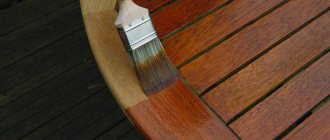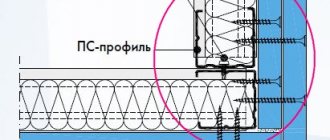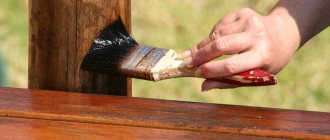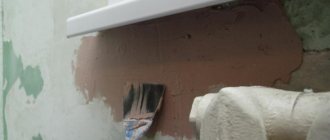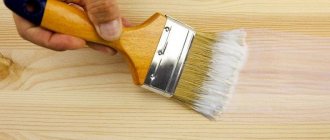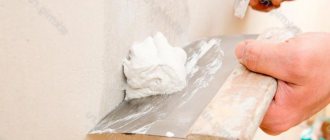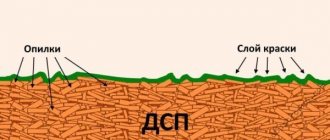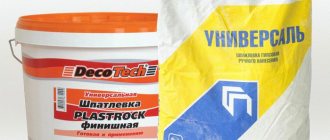Necessary materials and tools for filling corners
The most problematic and vulnerable to negative influences places in plasterboard sheets are the corners. Therefore, in order to avoid their damage during the operation of the home, it is necessary to putty the surface. Due to the difficulties of placing external and internal corners, special tools and materials have to be used during the procedure.
To carry out the work you need:
- Electric drill with a mixer attachment for mixing the solution. This procedure can be performed manually, but this will increase the time required to prepare the mixture.
- Spatulas with different widths, including corner models, sandpaper and a grater, or a block for rubbing surfaces.
- Construction or laser level. Using a tool, you can check the evenness of the coating.
- Tank for mixing raw materials. Specialists use a special construction container with a volume of 20 liters.
- Paint brushes, a construction knife and a plastic trowel.
The materials you will need to prepare are:
- Perforated corners
. You can take self-adhesive or rounded products made of plastic or metal. Each type performs its functions well. At the same time, rounded structures are in demand in rooms where children live, because... they eliminate the risk of damage in a collision. Metal or “arched” corners are flexible, so they can quickly adapt to any shape of the room.
- Starting putty mixture
. The selected solution must be of high quality. Before preparing the mass, you need to calculate the time required for kneading and the proportions. Popular products are putty from Axolit, Fugenfüller, Knauf and a number of other brands.
- Reinforcing mesh
. Necessary for increasing the strength of the coating and processing internal corners.
- Primer for drywall
. It is applied to increase adhesion between the putty solution and the base.
- Non-woven tape (serpyanka)
. Strengthens the resulting structure.
- Sandpaper
with slight graininess.
- PVA glue
, which is necessary for fixing the serpyanka.
Important aspects
Before you start working with drywall, you need to learn several important points when finishing it, which will allow you to achieve high results with your own hands.
If the work was performed in the wrong sequence and without following the technology, then most likely you will have to hire qualified specialists who will redo everything again. The material itself is quite fragile and requires careful handling during the work process.
Particular attention should be paid to internal and external corners. For their high-quality processing, there are special metal or plastic corners, which are applied to the joints at right angles and sealed with putty.
Also, to create even internal corners, special corner spatulas are used, since it is extremely difficult, or rather almost impossible, to create a perfectly even corner using a regular straight spatula, especially for a beginner.
Let's take a closer look at how to putty the corners of drywall and what tools and materials to use for this.
The photo shows an angled spatula.
Choice of putty
Before you putty the drywall, you need to choose the right solution.
A wide range of dry compounds are available in construction hypermarkets, so to select the appropriate mixture you need to understand the differences and features of all options. Some products are designed for ceilings and walls, others are designed for eliminating cracks and leveling slopes. Decorative putties are also on sale.
Depending on the purpose and composition of the mixture, the cost varies. Dry options are the most affordable, and their service life is quite long. Such material can be used in doses, which is especially important when performing emergency repair work. Ready-made compositions are not afraid of various environmental influences, but are more expensive.
Taking into account the raw materials, the following types of putty are distinguished:
- Polymer.
- Cement.
- Plaster.
All types are suitable for puttying plasterboard walls. But if we are talking about treating rooms with high humidity (kitchen, bathroom), it is better to use a cement-based mixture. Gypsum analogues do not withstand dampness, so over time cracks appear on their surface.
However, gypsum-based putties are suitable for most other purposes because... their structure meets strict criteria of quality and durability. Using the solution, you can prepare the surface for wallpapering and make it smooth.
Models made of polymer particles are in demand due to their plasticity. Their main purpose is to treat joints and problem areas.
Arch finishing: 10 popular methods and 3 simple instructions
To make the plasterboard arch disappear into the interior, it can be painted the same color as the wall. To highlight the opening beautifully, it, like the slopes, can be painted white. Ready-made kits and finishing corners are available for sale, which are made taking into account the dimensions of typical doorways. Ready-made sets differ in the radius and shape of the upper part. Decorative stone is a type of tile that is laid with tile adhesive. Due to its heavy weight, I recommend gluing decorative stone not to frame partitions, but to main walls. Are you about to finish an arch in your apartment and don’t know where to start? I'll tell you about 10 simple ways to finish an opening, and you can choose the option that suits you. I will also offer three simple instructions for finishing wall openings yourself.
Now you know how to decorate an arch yourself with polyurethane molding and other equally popular materials. If you have any questions, I recommend watching the video in this article. Write your ideas and considerations regarding the decoration of arches in the comments.
How to treat the surface → Room decoration → How to choose the right paint → Surface treatment technologies → Leveling and finishing the walls → Selecting and applying a primer → Removal from the surface → Stretch ceilings and technologies → Reviews and testimonials
Preparatory work
Before filling a plasterboard wall, you need to perform a number of steps.
You should proceed to this stage immediately after mixing the raw materials, adhering to the following algorithm:
- First, you should trim the corner cuts and get rid of defects.
- The intersection of surfaces must be carefully wiped with a rag so as not to damage the sheets.
- Then you need to prime the treated areas with a brush and wait until they are completely dry.
Once the primer has soaked into the drywall, you need to prepare the putty. To do this, you need to pour the amount of liquid recommended by the manufacturer into the container and add the powder. A drill with a mixer attachment is suitable for mixing, but you can also do it by hand.
For the solution to infuse, you need to wait 3-5 minutes. The mixing cycle is then repeated.
Sealing defects, seams and fastening points
To seal seams, it is convenient to use two spatulas - a small one. 10 - 15 cm and more, 30 - 40 cm.
Make sure that there are no cardboard peelings at the joints of the sheets. If you find this, carefully cut everything with a knife, sand the edges with sandpaper, prime and fill the area with putty.
When sealing joints, the edges of the cut sheets should be cut at an angle, creating a chamfer, as on the main sheets, this will create a stronger adhesion when filling the seam with putty.
Next, we clean the surface, prime the seam and fill it with putty, wait until it dries, apply a leveling layer, apply sickle tape, press it into the putty and level it with a spatula. Let it dry, then prime it and leave it for final drying.
In the places where the gypsum boards are attached to the profile, the putty is applied first along and then across, i.e. crosswise, so there will be no defects in the places where the screws are located.
Selecting corners for gypsum boards
There are several modifications of corners for drywall. They differ in material of manufacture and purpose.
Using a plastic corner like AquaBead
AquaBead is an ordinary plastic corner with a special paper with an adhesive mixture on the inner surface. To install the product, you do not need to pre-apply glue. Paper with an adhesive surface is treated with water, which leads to activation of the base.
Working with such corners looks like this:
- The base is checked for evenness using a water or laser level.
- Next, the adhesive part of the paper on the corner is moistened with a spray bottle or a wet brush.
- After a few seconds, you can fix the corner in the indicated place, making sure that the adhesiveness is not broken.
- 15-20 minutes after fixation, you can distribute the leveling layer.
Such parts are sold in most construction hypermarkets, but they are more expensive than analogues without an adhesive surface.
Metal perforated corner
If a classic metal corner is used, installation should be carried out according to the following instructions:
- Check the evenness of the surface using a level.
- Prepare a corner with the required dimensions.
- Mix the solution to fix the structure along the length of the corner.
- Apply the solution to both sides in small portions.
- Attach a corner and press it into the mixture, leveling it with a level.
The glue, which will be released through the holes in the corner when pressed, must be evenly distributed along the height with a spatula. Sometimes builders resort to a different fixation scheme, using a simple stapler.
Semicircular corner made of plastic
Such products are distinguished by the absence of sharp corners and are needed for use in those parts of the room where the risk of mechanical stress is maximum. The design is made of durable ABS plastic.
Before installing the corner, the end of the plasterboard sheet is cut in height by 1.5-2 cm, maintaining an angle of 45°. It is necessary to apply a thick layer of base putty solution and install the product into the treated end.
Before filling the surface, the position of the plastic corner must be corrected with a laser or water level. To strengthen the fixation, you can use a construction stapler. Having leveled the end, the remaining mixture must be removed with a sponge or rag.
Mixing the working mixture
We need two containers to make the solution in one, and pour water into the second, and periodically wash the mixer in it, because the gypsum hardens quickly and pieces from the mixer will interfere with us during the second mixing.
Tip: mix the solution in small portions, for about half an hour. If the solution has set, it is not recommended to dilute it with water a second time, as its plasticity is lost, and, in the future, this layer may begin to crumble and crumble.
We dilute the mixture strictly according to the instructions, to the consistency of thick sour cream.
How to putty the inside corners of drywall
In most cases, filling of internal corners is carried out using plastic corners, complete with an installed stack for reinforcing the joints. But if you have an angle spatula at your disposal, you can get by with just a mounting grid.
Before processing the corners of gypsum boards, it is necessary to organize high-quality adhesion of the sheets at the junction. In case of strong vibrations, cracks and cracks appear in these places.
Puttying is done something like this:
- A mounting mesh is applied to the joints so that the center of the cavity is clearly located in the center.
- On top of this mesh you need to apply prepared putty along the height of the corner.
- Then the corner should be leveled with an angle spatula.
It is recommended to align all parts of the corner one by one.
When drywall joints appear on the wall
You can work with GC sheets using one of the following methods:
- Frame installation of gypsum boards;
- A frameless method of fixing drywall to a surface.
The frame method is the creation of a sheathing from metal profiles and additional materials for sheathing with sheets. Wooden slats are also used, but less often, since wood is a capricious material that requires certain conditions for work and processing.
The frameless method involves gluing sheets to the base using various adhesive mixtures and more.
In both cases, after installing the HA sheets on the base, seams appear - a border between 2 sheets.
The joint must be correctly formed:
- the gap between the sheets should be no more than 2 mm;
- there should be a chamfer - a kind of groove along the entire border. The plasterboard sheet has a rounded edge, but if the sheet is cut, the edge is immediately cut at 45 degrees with a plane (milling cutter). Masters, in a hurry or because of laziness, do not create this chamfer. Then, using a construction knife, you need to make a recess yourself at the borders of the sheets.
- The joint on the gypsum board must be smooth, without cracks or deformation.
The chamfer plays an important role. It increases the rigidity of the plasterboard surface. A properly sealed joint is a guarantee of the strength of the entire structure.
How to putty the outside corners of drywall
Puttying external corners is quite difficult.
In addition to the materials and tools mentioned earlier, you will need to prepare:
- Perforated, plastic or metal corners.
- A device for cutting metal or plastic products.
- Building level.
Next you need to follow these instructions:
- At the first stage, you should determine the length and cut off the required part of the corner.
- Then you need to make sure the slope is level using a level. If there are no deviations, you can proceed to applying the putty solution. If there are defects, it is worth partially opening the material and treating the problem areas with putty.
- Next, you need to install a corner in the desired part of the sheet and press it lightly until the putty begins to squeeze out through the holes.
- Using a level, make sure that the corner is evenly positioned. If necessary, it is worth additionally fixing the product in certain places.
- The remaining mixture is distributed evenly over the perforated corner.
- Before the subsequent stages of puttying, you need to sand the base layer using sandpaper and then apply a primer.
- The finishing solution is distributed in a thin layer. It is necessary for masking defects, differences in height, etc.
Plastering slopes.
Slopes on windows, doors and other openings are especially important places, since a person looking there automatically compares them with a window or door. That is, with straight lines. This means that no deviations are allowed - deviations from the lines of the window or door. As for matching the level, the windows can easily be slightly blocked.
Therefore, slopes are plastered mainly according to level. It is recommended to use a corner for plastering slopes. And, again, as a plaster beacon. If the slopes were mounted from gypsum fiber board or gypsum board, and not of very high quality, then a perforated corner will help eliminate all the shortcomings.
By the way, before installing gypsum plasterboard or sandwich panels on slopes, the basic brick slope, according to technology, must be covered with plaster. The perforated corner installed at the same time will help to correctly align the sheet of drywall.
The final stage
If you plan to decorate the wall with non-woven or other types of wallpaper with a texture or three-dimensional pattern, you will simply need to rub the corners with a mesh or sandpaper. If the surface will be painted or covered with paper wallpaper without embossing, it is important to achieve a smooth surface.
To do this, you will need to once again treat the plane and corners with finishing putty, which eliminates unevenness and makes the surface attractive.
Before putting drywall in the corners, they need to be primed. Having distributed the finishing mixture, you need to stick non-woven tape over it and level the putty with a spatula. This will allow the tape to soak and harden, increasing the degree of reinforcement and resistance of the base to mechanical loads.
Then you need to apply the final leveling layer of putty and wait 2-3 days until it is completely dry.
At the last stage, grouting should be done using sandpaper or a grouting mesh. This treatment will smooth out all the unevenness and make the surface even and smooth.
Drywall corner - types of products and features of their use
Don’t know how to make perfectly even corners in plasterboard structures? Then this review is for you, in it I will talk about the types of corners used in the work and show you step by step the process of installing them. By following simple recommendations, you can easily make strong and perfectly even corners.
There are corners for both flat and arched structures
Applying primer
Cover the sanded and dust-free surface with a primer.
Tip: for gypsum plasterboard, use only water-based primer. Alkyds are not suitable for finishing drywall; sometimes they cause deformation of the cardboard layer and swelling and cracks may form at the site of their application. The primer is applied with a roller, from top to bottom, forming a layer of at least 0.03 mm.
